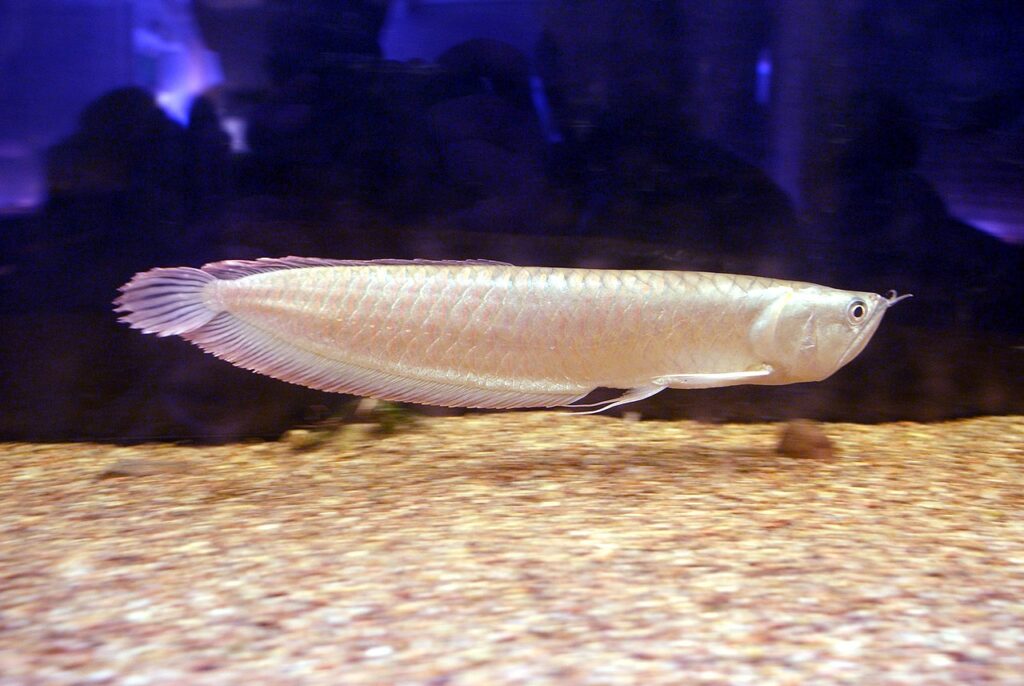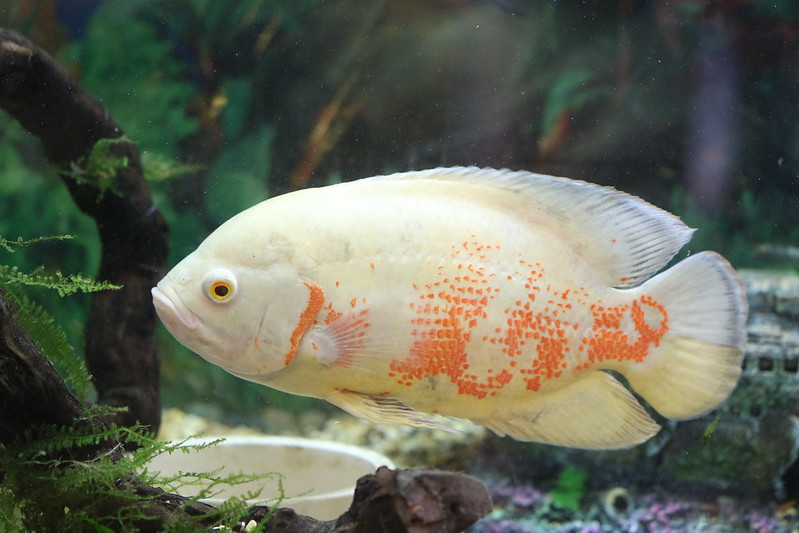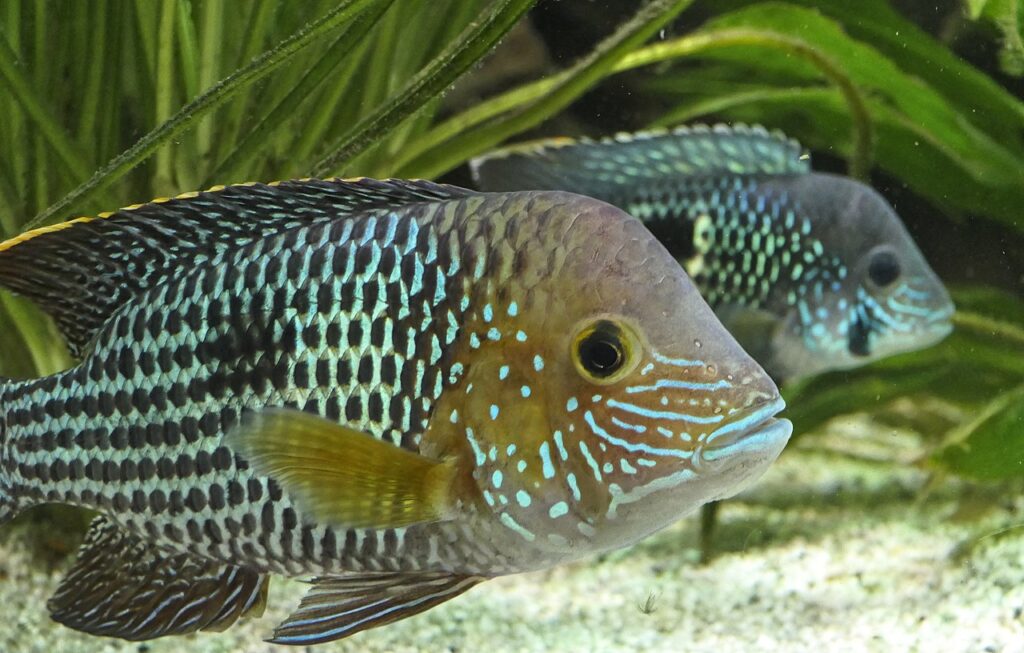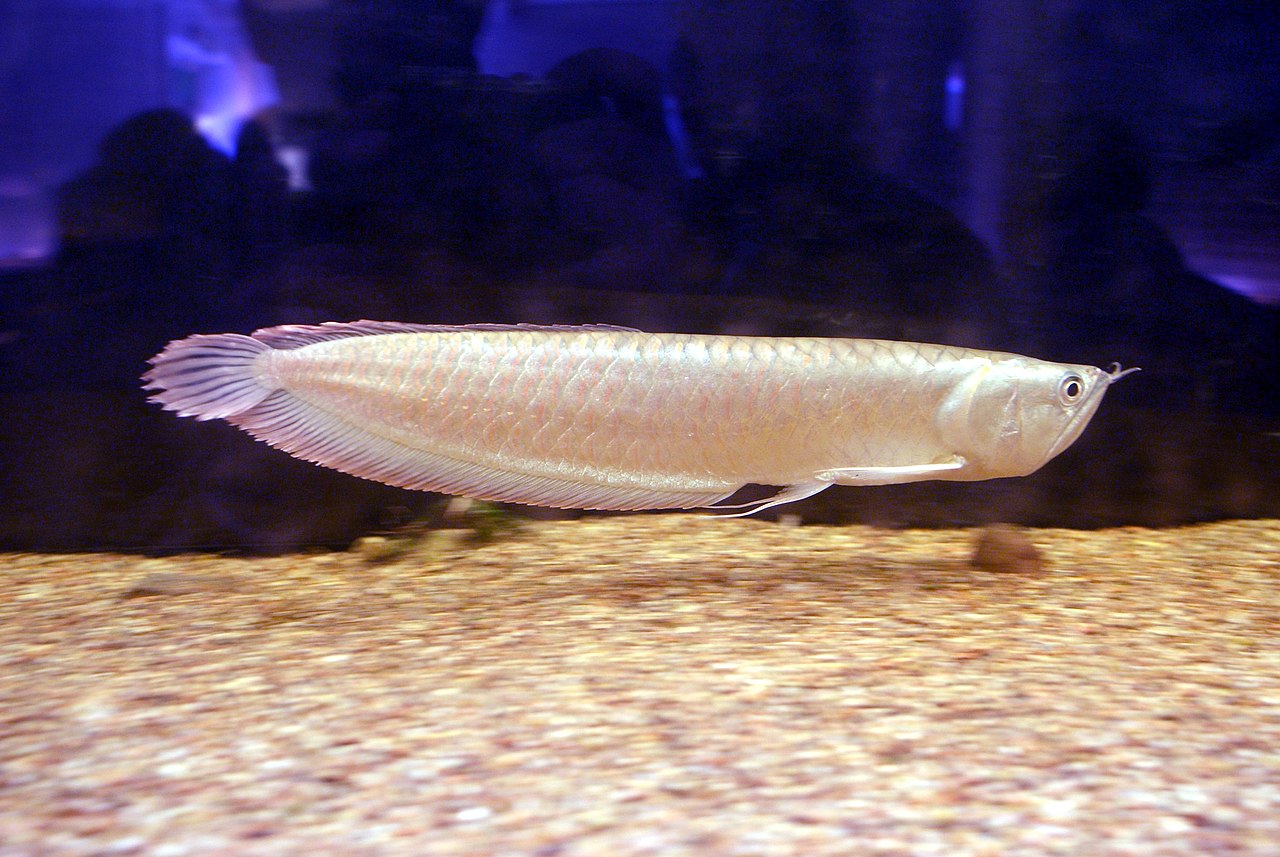Imagine a fish that can leap out of water to snatch birds mid-flight! That’s the Silver Arowana, a living fossil with a lineage older than T-Rex. This water-dwelling acrobat, known scientifically as Osteoglossum bicirrhosum, isn’t your average aquarium dweller. With its shimmering scales and dragon-like appearance, it’s no wonder fish fans call it the “water monkey” or “dragon fish.” But don’t let its fierce looks fool you – this prehistoric swimmer has some tricks up its fins that’ll make your jaw drop!
Table of Contents
Native to the Amazon basin, these remarkable fish have adapted to life in both black and white water habitats. They’re top-dwellers, preferring to swim near the surface where they can easily spot insects, small fish, and even birds flying low over the water. Their upward-facing mouth is perfectly designed for snatching prey from above.
The name Osteoglossum bicirrhosum has an interesting meaning. “Osteo” means bone, and “glossum” refers to tongue, describing their bony tongue-like structure. “Bicirrhosum” means two barbels, referring to the pair of whisker-like sensory organs on their lower jaw.
In the aquarium trade, you might hear them called Silver Arowanas, Dragon Fish, or Monkey Fish. No matter what you call them, these fish are sure to impress with their size, growing up to 4 feet long in the wild!
A study published in the Journal of Fish Biology found that Silver Arowanas have a unique way of caring for their young. The male fish incubates the eggs in his mouth for about 50 days, only releasing the fully-formed fry when they’re ready to swim on their own.
These fish are not just beautiful; they’re also believed to bring good luck and prosperity in some cultures. In fact, they’re so valued that some varieties can fetch prices in the thousands of dollars!
If you’re thinking of keeping a Silver Arowana, be prepared for a big commitment. They need large tanks, specialized care, and a diet that mimics their natural prey. But for those willing to put in the effort, watching these living fossils swim and jump can be an incredible experience.
From their prehistoric origins to their modern-day status as prized aquarium fish, Silver Arowanas continue to fascinate and surprise us. Whether you’re an experienced aquarist or just a fish enthusiast, there’s always something new to learn about these remarkable creatures.

Silver Arowana Key Information
The Silver Arowana is a sight to behold, with its sleek, elongated body covered in large, reflective scales that shimmer like polished metal. While primarily silver in color, these magnificent fish can display subtle hues of blue, green, or pink, depending on the lighting and their mood. Their large, upward-facing mouths and prominent barbels add to their prehistoric appearance, making them a true showstopper in any aquarium.
| Family | Osteoglossidae |
| Origin | Amazon River basin in South America |
| Price | $50 to $500+, depending on size and quality |
| Common Names | Dragon Fish, Monkey Fish, Water Monkey |
| Variants | Silver, Black, Asian (not true Arowana) |
| Ideal Tank Size | Minimum 250 gallons for adults |
| Water Parameters | pH 6.0-7.0, temperature 75-82°F (24-28°C) |
| Lifespan | 10-15 years in captivity, up to 20 in optimal conditions |
| Full Size | Up to 4 feet (1.2 meters) in the wild, 2-3 feet in captivity |
| Natural Environment | Slow-moving rivers, floodplains, and flooded forests |
| Behavior | Top-dweller, active jumper, territorial |
| Habitat Preference | Open swimming areas with floating plants for cover |
| Aquarium Decoration | Driftwood, large rocks, floating plants, open swimming space |
| Ideal Tank Mates | Large, peaceful fish like oscars, pacus, or other large cichlids |
| Fish to Avoid | Small fish (may be seen as food), aggressive species |
| Best Foods/Diet | Carnivore: live fish, insects, crustaceans, high-quality pellets |
| Disease | Prone to dropsy, fin rot, and parasitic infections |
| Sex-switch | No known sex-switching behavior |
| Gender Differences | Difficult to distinguish; females may be slightly larger |
| Care Level | Advanced – requires large tank, specific diet, and experienced care |
| Breeding Level | Very difficult in captivity; rarely achieved by hobbyists |
Ideal Tank Mates for Silver Arowana
The Silver Arowana is a fascinating and unique fish that requires careful consideration when selecting tank mates. Due to its size, predatory nature, and specific habitat preferences, not all fish are suitable companions. However, there are several species that can coexist peacefully with the Silver Arowana, provided the aquarium is large enough and properly maintained.
Here are 10 ideal tank mates for the Silver Arowana, each offering a unique dynamic to the aquarium ecosystem:
1. Oscar (Astronotus ocellatus)

Oscars are an excellent choice as tank mates for Silver Arowanas. These large, intelligent cichlids occupy the middle to lower regions of the tank, complementing the Arowana’s preference for the upper water column. Oscars are robust enough to hold their own against the Arowana and share similar water parameter requirements. Their interactive nature and size make them interesting companions without competing for the same space or food sources.
| Common/Market Names | Price Range | Care Level | Behavior | Life Span | Max Size |
|---|---|---|---|---|---|
| Oscar, Velvet Cichlid, Marble Cichlid | $10-$100 | Moderate | Semi-aggressive | 10-20 years | 12-14 inches |
2. Clown Knife Fish (Chitala ornata)
The Clown Knife Fish is a fascinating addition to an Arowana tank. Its unique, knife-like body shape and nocturnal habits make it an intriguing contrast to the Arowana. While both species are predatory, they occupy different niches in the aquarium. The Clown Knife Fish prefers the lower regions of the tank and is active at night, while the Arowana dominates the upper areas during the day. This temporal and spatial separation helps reduce potential conflicts.
| Common/Market Names | Price Range | Care Level | Behavior | Life Span | Max Size |
|---|---|---|---|---|---|
| Clown Featherback, Clown Knifefish | $50-$200 | Advanced | Predatory, Nocturnal | 10-15 years | 30-36 inches |
3. Green Terror Cichlid (Andinoacara rivulatus)

Despite its name, the Green Terror Cichlid can be a suitable tank mate for Silver Arowanas. These cichlids are known for their striking coloration and relatively peaceful nature compared to other large cichlids. They occupy the middle to lower regions of the tank, which complements the Arowana’s preference for the upper areas. Their hardy nature and similar water parameter requirements make them compatible companions.
| Common/Market Names | Price Range | Care Level | Behavior | Life Span | Max Size |
|---|---|---|---|---|---|
| Gold Saum, Green Terror | $15-$50 | Moderate | Semi-aggressive | 7-10 years | 8-12 inches |
4. Pacu (Piaractus brachypomus)
Pacus are large, peaceful relatives of piranhas that make excellent tank mates for Silver Arowanas. Their omnivorous diet and preference for the middle to lower regions of the tank reduce competition with the Arowana. Pacus are known for their social nature and can add a dynamic element to the aquarium. Their size and hardiness make them well-suited to coexist with Arowanas in large tanks.
| Common/Market Names | Price Range | Care Level | Behavior | Life Span | Max Size |
|---|---|---|---|---|---|
| Red-bellied Pacu, Pirapitinga | $20-$100 | Moderate | Peaceful | 15-25 years | 24-36 inches |
5. Plecostomus (Hypostomus plecostomus)
Plecos are excellent bottom-dwelling companions for Silver Arowanas. These algae-eating catfish help maintain tank cleanliness while occupying a completely different niche than the Arowana. Their armored bodies and nocturnal habits make them less likely to be seen as prey. Plecos also contribute to the overall ecosystem of the tank by consuming algae and leftover food.
| Common/Market Names | Price Range | Care Level | Behavior | Life Span | Max Size |
|---|---|---|---|---|---|
| Common Pleco, Sucker Fish | $5-$30 | Easy | Peaceful | 10-15 years | 12-24 inches |
6. Freshwater Stingray (Potamotrygon sp.)
Freshwater stingrays are unique and fascinating tank mates for Silver Arowanas. These bottom-dwelling fish occupy a completely different part of the tank and have a very different body shape, reducing competition and potential conflicts. Stingrays add an exotic element to the aquarium and share similar water parameter requirements with Arowanas. Their peaceful nature and interesting behaviors make them compatible companions.
| Common/Market Names | Price Range | Care Level | Behavior | Life Span | Max Size |
|---|---|---|---|---|---|
| Motoro Ray, Ocellate River Stingray | $200-$1000+ | Advanced | Peaceful | 15-20 years | 12-24 inches (disc width) |
7. Bichir (Polypterus sp.)
Bichirs are prehistoric-looking fish that make intriguing tank mates for Silver Arowanas. These bottom-dwelling predators have a unique appearance and behavior that complements the Arowana’s presence in the upper water column. Bichirs are hardy and adaptable, sharing similar water parameter requirements. Their nocturnal habits and different feeding patterns reduce competition with the Arowana.
| Common/Market Names | Price Range | Care Level | Behavior | Life Span | Max Size |
|---|---|---|---|---|---|
| Dinosaur Eel, Dragon Fish | $30-$150 | Moderate | Predatory, Nocturnal | 10-15 years | 12-30 inches (species dependent) |
8. Tinfoil Barb (Barbonymus schwanenfeldii)
Tinfoil Barbs are large, active schooling fish that can coexist peacefully with Silver Arowanas. These fish occupy the middle regions of the tank and are fast swimmers, making them less likely to be seen as prey. Their schooling behavior adds movement and interest to the aquarium, complementing the Arowana’s solitary nature. Tinfoil Barbs are also hardy and adaptable, sharing similar water parameter requirements.
| Common/Market Names | Price Range | Care Level | Behavior | Life Span | Max Size |
|---|---|---|---|---|---|
| Silver Barb, Barbonymus | $5-$20 | Easy | Active, Schooling | 5-8 years | 10-14 inches |
9. Flagtail Prochilodus (Semaprochilodus taeniurus)
Flagtail Prochilodus are peaceful, schooling fish that make excellent tank mates for Silver Arowanas. These fish are known for their unique feeding habits, consuming algae and detritus from the substrate. Their constant foraging behavior helps keep the tank clean while providing interesting movement in the lower regions of the aquarium. Their large size and fast swimming ability make them less likely to be seen as prey by the Arowana.
| Common/Market Names | Price Range | Care Level | Behavior | Life Span | Max Size |
|---|---|---|---|---|---|
| Flagtail, Banner Tetra | $20-$50 | Moderate | Peaceful, Schooling | 5-8 years | 10-12 inches |
10. Geophagus (Geophagus sp.)
Geophagus cichlids are peaceful, substrate-sifting fish that make interesting tank mates for Silver Arowanas. These cichlids occupy the bottom regions of the tank, constantly sifting through the substrate for food. This behavior not only helps keep the tank clean but also provides a fascinating contrast to the Arowana’s surface-dwelling habits. Geophagus cichlids are generally peaceful and their earthy colors complement the Arowana’s silver sheen.
| Common/Market Names | Price Range | Care Level | Behavior | Life Span | Max Size |
|---|---|---|---|---|---|
| Eartheater Cichlid, Geophagus | $20-$100 | Moderate | Peaceful | 8-10 years | 6-12 inches (species dependent) |
FAQs about Silver Arowana
How often should I feed my Silver Arowana?
Adult Silver Arowanas should be fed 2-3 times a week. Younger specimens may require more frequent feeding, up to once daily. Always monitor your fish’s body condition and adjust feeding accordingly to prevent overfeeding.
Can Silver Arowanas recognize their owners?
Yes, Silver Arowanas are intelligent fish and can recognize their owners over time. They may become more active or approach the front of the tank when they see familiar faces, especially at feeding times.
Do Silver Arowanas need special lighting?
While Silver Arowanas don’t have specific lighting requirements, they benefit from a regular day-night cycle. Use moderate lighting that mimics their natural habitat, avoiding overly bright lights that may stress them.
How can I tell if my Silver Arowana is stressed?
Signs of stress in Silver Arowanas include loss of appetite, rapid breathing, erratic swimming, color changes, and hiding more than usual. If you notice these signs, check water parameters and tank conditions immediately.
Are Silver Arowanas suitable for community tanks?
Silver Arowanas are generally not suitable for community tanks due to their large size, predatory nature, and specific care requirements. They’re best kept in species-specific tanks or with other large, compatible fish.
How often should I perform water changes for my Silver Arowana?
Perform weekly water changes of 25-30% to maintain good water quality. In heavily stocked tanks or those with high nitrate levels, you may need to increase the frequency or volume of water changes.
Can Silver Arowanas live in outdoor ponds?
Silver Arowanas can live in outdoor ponds in tropical climates where temperatures remain consistently warm. However, they require very large ponds with proper filtration and may pose a risk to local ecosystems if they escape.
How do I acclimate a new Silver Arowana to my tank?
Acclimate your Silver Arowana slowly over 1-2 hours using the drip method. This allows the fish to adjust to the new water parameters gradually, reducing stress and the risk of shock.
What should I do if my Silver Arowana stops eating?
If your Silver Arowana stops eating, first check water parameters and temperature. Try offering a variety of foods, including live options. If the problem persists for more than a few days, consult a veterinarian specializing in fish.
Can Silver Arowanas change color?
While Silver Arowanas don’t dramatically change color like some fish species, their coloration can become more intense or slightly alter based on factors such as diet, water quality, and overall health.

Leave a Reply